
Camponotus mina is a species of carpenter ant native to large parts of northern Mexico, California, Arizona, Texas, and New Mexico, and possibly Wyoming, South Dakota, and Minnesota.
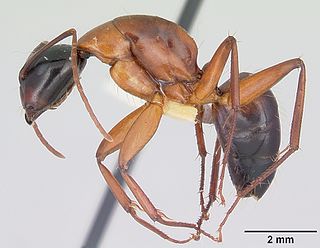
Camponotus texanus is a species of carpenter ant native to Texas, Nuevo Leon, and possibly Arizona.

Camponotus vicinus is a species of carpenter ant widespread throughout western North America; it is found from Alaska, south to Mexico, and east to Texas and Manitoba. Unlike its wood-nesting relatives, C. vicinus is typically found nesting in the soil under stones and other objects.

Camponotus ocreatus is a species of carpenter ant native to northern Mexico and the southwestern United States.

Camponotus semitestaceus is a species of carpenter ant native to the western United States, British Columbia, Baja California, and possibly Veracruz.

Camponotus discolor is a species of carpenter ant native to the eastern United States, North Dakota, Nebraska, Texas, Kansas, Oklahoma, Nuevo Leon, Tamaulipas, and possibly California, Montana, Utah, and Colorado.
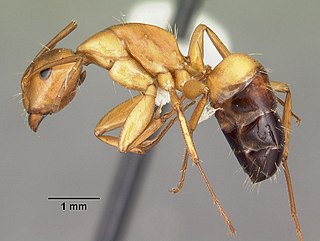
Camponotus snellingi is a species of carpenter ant native to the southeastern United States and possibly Arizona.
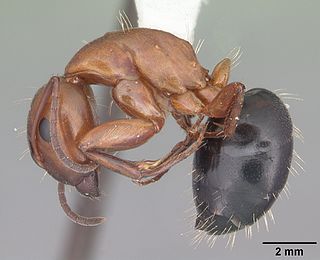
Camponotus decipiens is a species of carpenter ant native to the eastern United States, North Dakota, Nebraska, Kansas, Colorado, Texas, Tamaulipas, Nuevo Leon, San Luis Potosi, and possibly Utah, Arizona, Sonora, and California.

Camponotus chromaiodes, known generally as, the ferruginous carpenter ant or red carpenter ant, is a species of carpenter ant native to the eastern United States, Nebraska, Kansas, and possibly California. Acetobacteraceae are found in the guts of workers in this species.
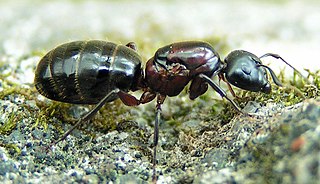
Camponotus novaeboracensis, the New York carpenter ant, is a species of carpenter ant native to the United States, Canada, possibly found in Costa Rica, Malaysia, and invasive in Bermuda.

Camponotus essigi is a species of carpenter ant native to the western United States, possibly Coahuila, and invasive in Trinidad and Tobago.
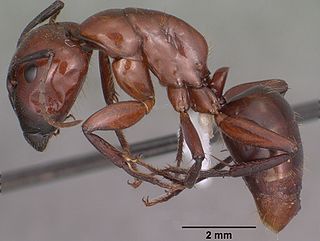
Camponotus schaefferi is a species of carpenter ant native to Arizona, New Mexico, and possibly Venezuela.

Camponotus subbarbatus. also known as the bearded carpenter ant, is a species of carpenter ant native to eastern North America.
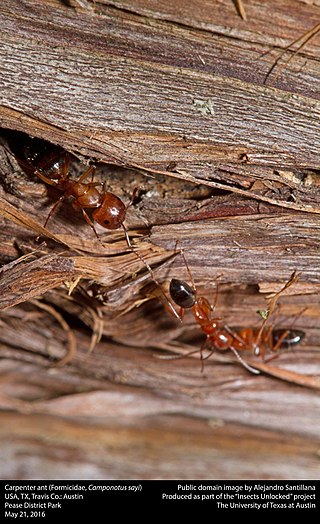
Camponotus sayi is a species of carpenter ant native to the southwest United States, northern Mexico, and possibly North Dakota, Ontario, Mississippi, North Carolina, South Carolina, and Florida.

Camponotus clarithorax is a species of carpenter ant of the subgenus Camponotus native to California, Oregon, the Baja California Peninsula, and possibly the eastern United States. This species is found in Oregon, California, and Baja California.

Camponotus sericeiventris, the shimmering golden sugar ant, is a species of carpenter ant native to large parts of Central and South America.

Camponotus obscuripes is a species of carpenter ant native to Japan, Sakhalin, the Kuril Islands, Jeju Island, and possibly other parts of East Asia and Russia.

Camponotus microps is a species of carpenter ant native to Arizona, New Mexico, Sonora, Queretaro, and Guanajuato. This species was separated from the Camponotus festinatus complex in 2006 by Roy Snelling.

Camponotus pudorosus is a species of carpenter ant native to Arizona, New Mexico, Colorado, Mexico, and Guatemala. Originally described in 1925 by Carlo Emery and synonymized by W. W. Kempf in 1972, the species was revived in 2006 from the Camponotus festinatus complex by Roy Snelling.

Camponotus vafer is a species of carpenter ant native to northern Mexico, Texas, New Mexico, Oklahoma, Arizona, and possibly Wyoming.



















